Report: Swiss Air's Strategic Management for Competitive Advantage
VerifiedAdded on 2022/09/02
|14
|2867
|18
Report
AI Summary
This report provides an in-depth analysis of Swiss Air's management strategies for maintaining its competitive advantage within the airline industry. It begins with a description of the company, its management structure, target market, and key competitors. The report then delves into the specific strategies employed by Swiss Air's management team, including marketing strategies (product, price, place, and promotion), customer relationship management, service design, quality management, sustainability practices, and social responsibility initiatives. Each strategy is examined in detail, highlighting its key components and implementation. The report also assesses the effectiveness of each strategy in relation to the overall success of the business, drawing upon Porter's Generic Model to evaluate competitive advantages. The analysis covers the airline's response to competition from low-cost carriers, its efforts to attract wealthier customers through cabin refurbishments and enhanced services, and its commitment to environmental sustainability and employee well-being. The report concludes with an assessment of how these strategies contribute to Swiss Air's ability to maintain its position in the market.
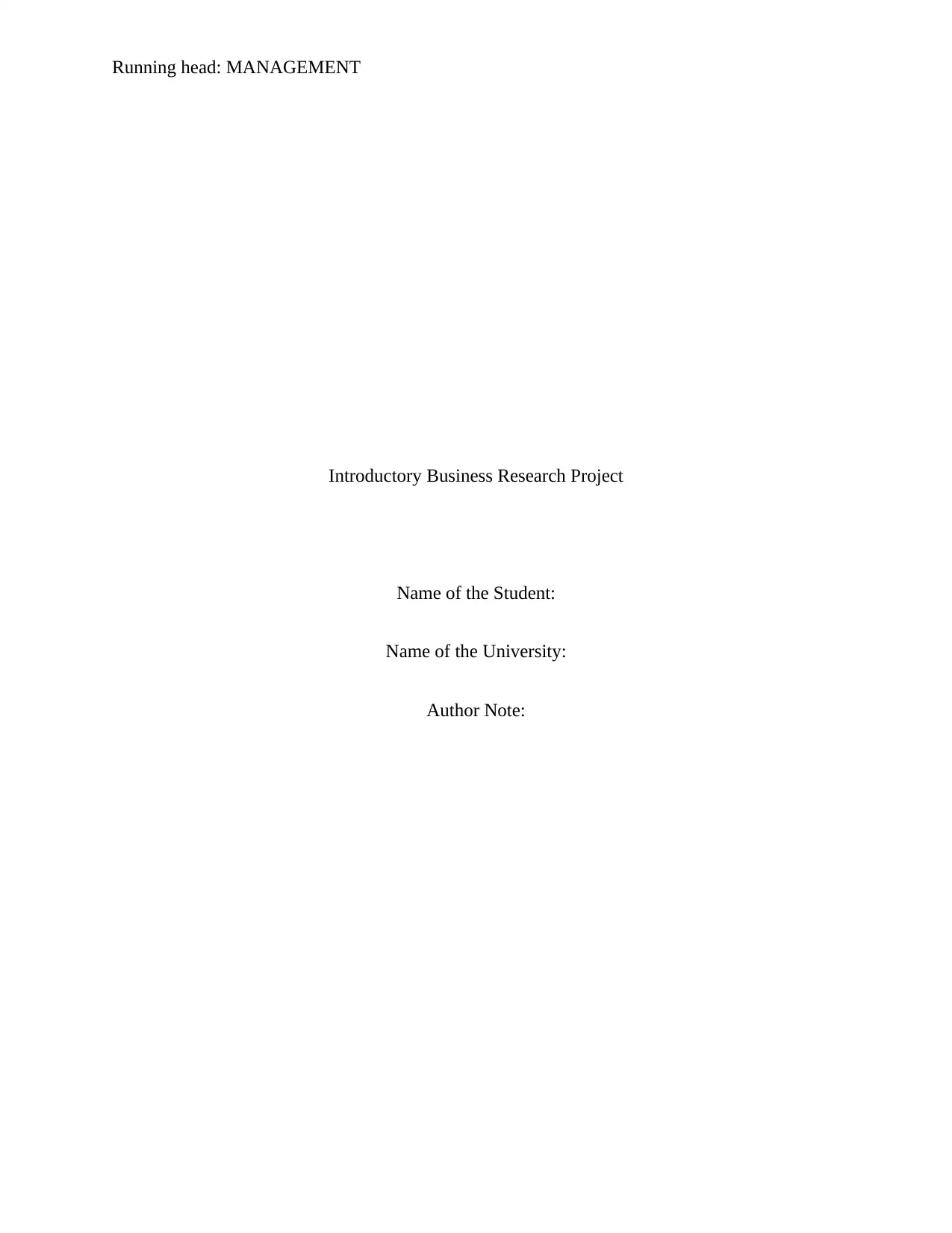
Running head: MANAGEMENT
Introductory Business Research Project
Name of the Student:
Name of the University:
Author Note:
Introductory Business Research Project
Name of the Student:
Name of the University:
Author Note:
Paraphrase This Document
Need a fresh take? Get an instant paraphrase of this document with our AI Paraphraser
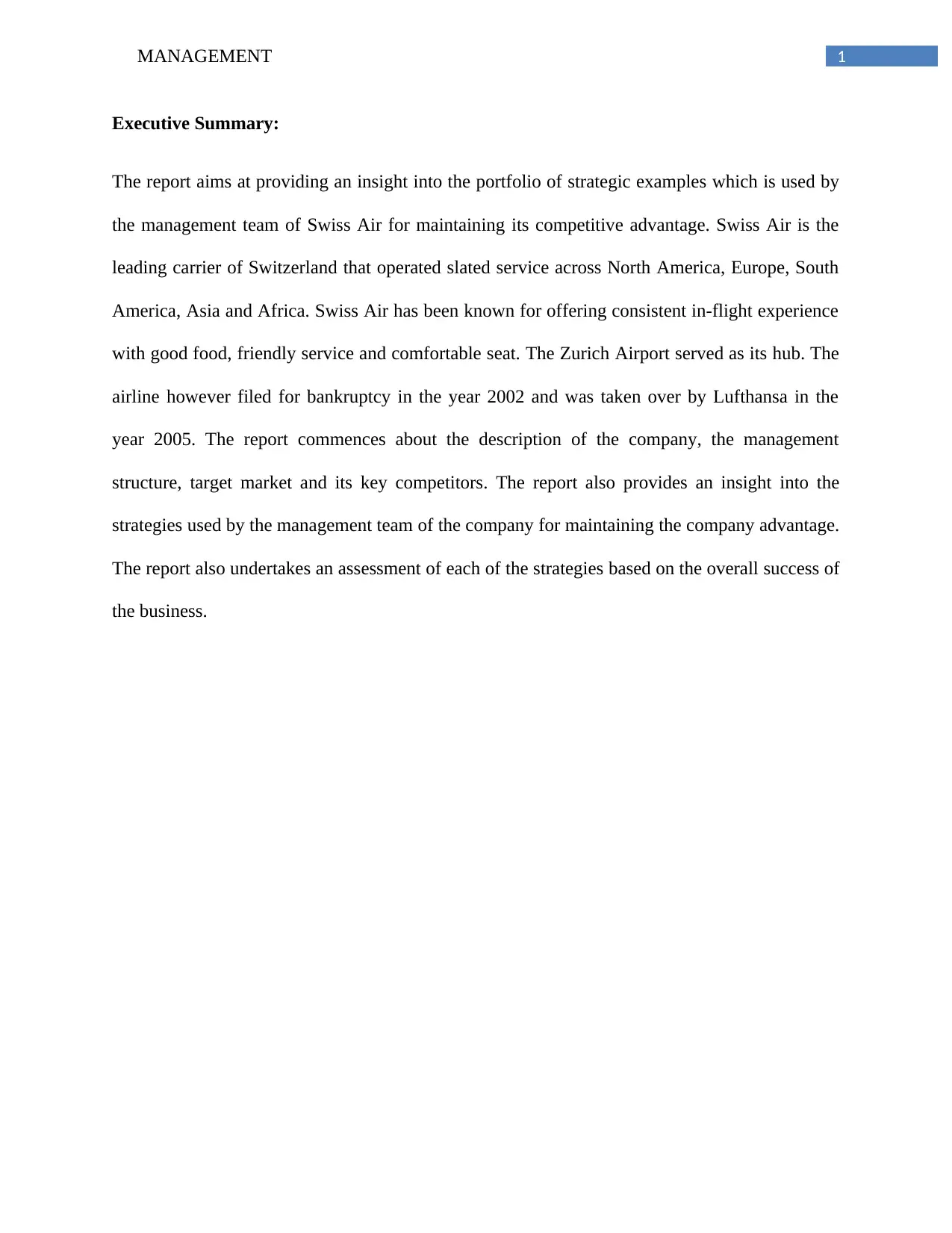
1MANAGEMENT
Executive Summary:
The report aims at providing an insight into the portfolio of strategic examples which is used by
the management team of Swiss Air for maintaining its competitive advantage. Swiss Air is the
leading carrier of Switzerland that operated slated service across North America, Europe, South
America, Asia and Africa. Swiss Air has been known for offering consistent in-flight experience
with good food, friendly service and comfortable seat. The Zurich Airport served as its hub. The
airline however filed for bankruptcy in the year 2002 and was taken over by Lufthansa in the
year 2005. The report commences about the description of the company, the management
structure, target market and its key competitors. The report also provides an insight into the
strategies used by the management team of the company for maintaining the company advantage.
The report also undertakes an assessment of each of the strategies based on the overall success of
the business.
Executive Summary:
The report aims at providing an insight into the portfolio of strategic examples which is used by
the management team of Swiss Air for maintaining its competitive advantage. Swiss Air is the
leading carrier of Switzerland that operated slated service across North America, Europe, South
America, Asia and Africa. Swiss Air has been known for offering consistent in-flight experience
with good food, friendly service and comfortable seat. The Zurich Airport served as its hub. The
airline however filed for bankruptcy in the year 2002 and was taken over by Lufthansa in the
year 2005. The report commences about the description of the company, the management
structure, target market and its key competitors. The report also provides an insight into the
strategies used by the management team of the company for maintaining the company advantage.
The report also undertakes an assessment of each of the strategies based on the overall success of
the business.
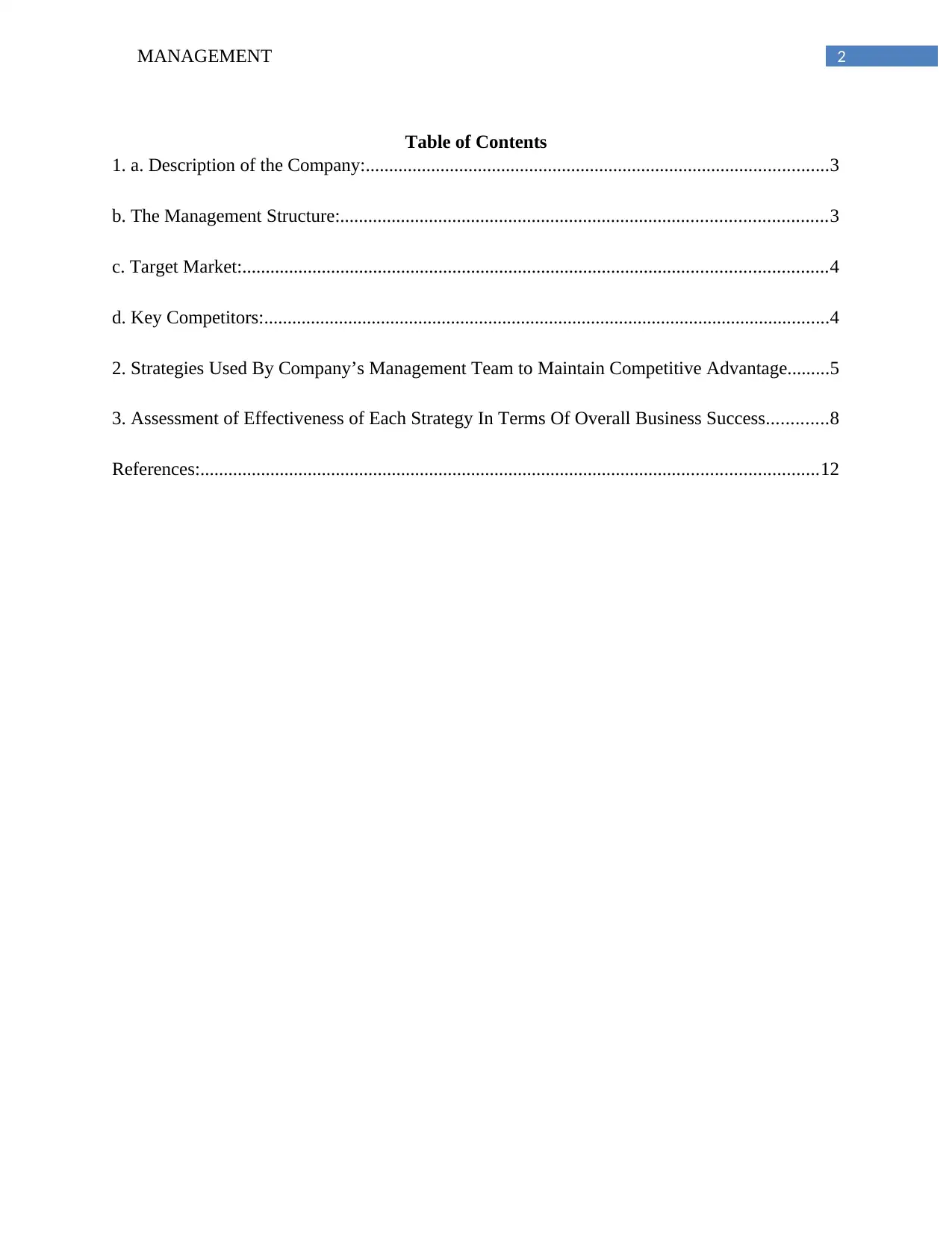
2MANAGEMENT
Table of Contents
1. a. Description of the Company:...................................................................................................3
b. The Management Structure:........................................................................................................3
c. Target Market:.............................................................................................................................4
d. Key Competitors:.........................................................................................................................4
2. Strategies Used By Company’s Management Team to Maintain Competitive Advantage.........5
3. Assessment of Effectiveness of Each Strategy In Terms Of Overall Business Success.............8
References:....................................................................................................................................12
Table of Contents
1. a. Description of the Company:...................................................................................................3
b. The Management Structure:........................................................................................................3
c. Target Market:.............................................................................................................................4
d. Key Competitors:.........................................................................................................................4
2. Strategies Used By Company’s Management Team to Maintain Competitive Advantage.........5
3. Assessment of Effectiveness of Each Strategy In Terms Of Overall Business Success.............8
References:....................................................................................................................................12
⊘ This is a preview!⊘
Do you want full access?
Subscribe today to unlock all pages.

Trusted by 1+ million students worldwide
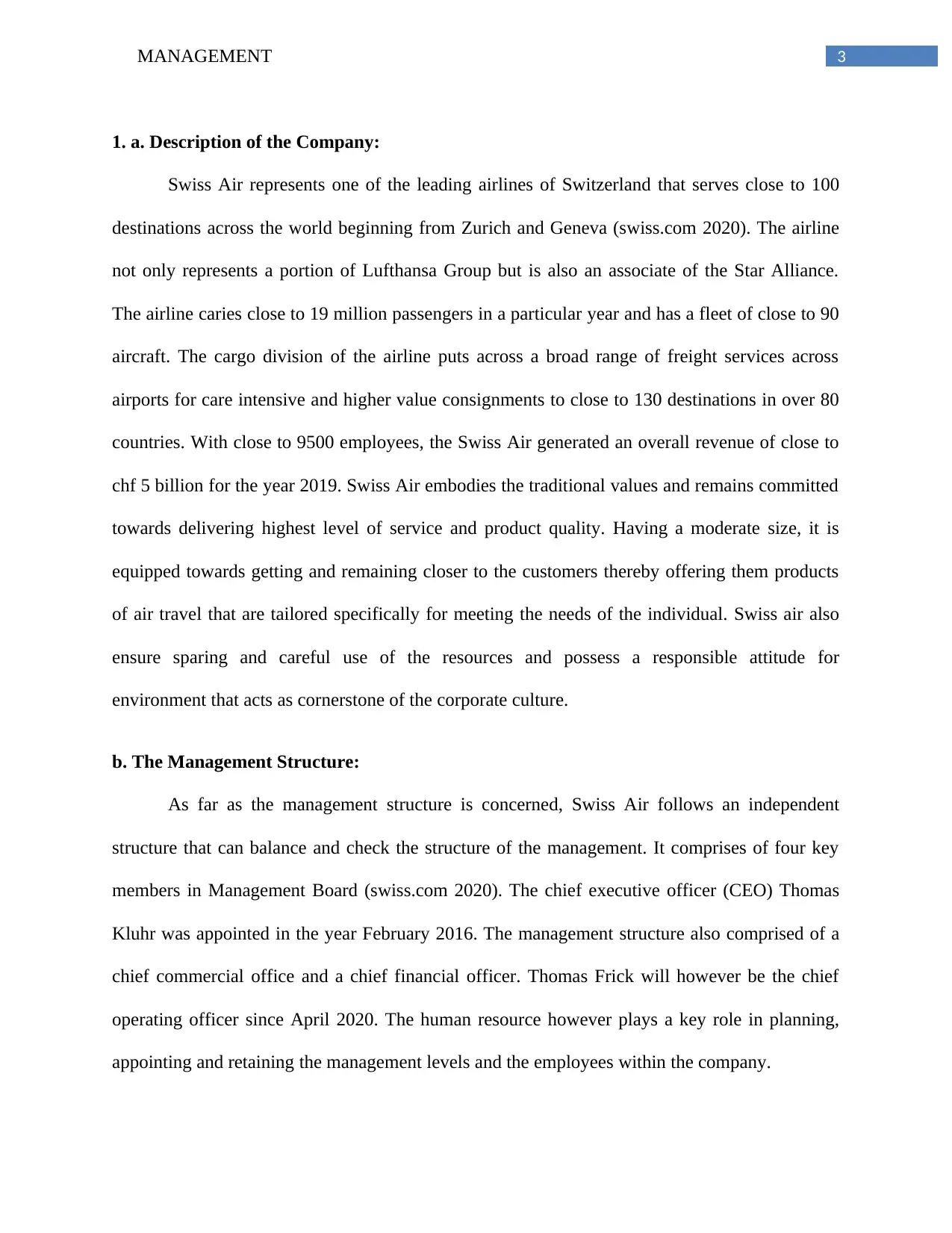
3MANAGEMENT
1. a. Description of the Company:
Swiss Air represents one of the leading airlines of Switzerland that serves close to 100
destinations across the world beginning from Zurich and Geneva (swiss.com 2020). The airline
not only represents a portion of Lufthansa Group but is also an associate of the Star Alliance.
The airline caries close to 19 million passengers in a particular year and has a fleet of close to 90
aircraft. The cargo division of the airline puts across a broad range of freight services across
airports for care intensive and higher value consignments to close to 130 destinations in over 80
countries. With close to 9500 employees, the Swiss Air generated an overall revenue of close to
chf 5 billion for the year 2019. Swiss Air embodies the traditional values and remains committed
towards delivering highest level of service and product quality. Having a moderate size, it is
equipped towards getting and remaining closer to the customers thereby offering them products
of air travel that are tailored specifically for meeting the needs of the individual. Swiss air also
ensure sparing and careful use of the resources and possess a responsible attitude for
environment that acts as cornerstone of the corporate culture.
b. The Management Structure:
As far as the management structure is concerned, Swiss Air follows an independent
structure that can balance and check the structure of the management. It comprises of four key
members in Management Board (swiss.com 2020). The chief executive officer (CEO) Thomas
Kluhr was appointed in the year February 2016. The management structure also comprised of a
chief commercial office and a chief financial officer. Thomas Frick will however be the chief
operating officer since April 2020. The human resource however plays a key role in planning,
appointing and retaining the management levels and the employees within the company.
1. a. Description of the Company:
Swiss Air represents one of the leading airlines of Switzerland that serves close to 100
destinations across the world beginning from Zurich and Geneva (swiss.com 2020). The airline
not only represents a portion of Lufthansa Group but is also an associate of the Star Alliance.
The airline caries close to 19 million passengers in a particular year and has a fleet of close to 90
aircraft. The cargo division of the airline puts across a broad range of freight services across
airports for care intensive and higher value consignments to close to 130 destinations in over 80
countries. With close to 9500 employees, the Swiss Air generated an overall revenue of close to
chf 5 billion for the year 2019. Swiss Air embodies the traditional values and remains committed
towards delivering highest level of service and product quality. Having a moderate size, it is
equipped towards getting and remaining closer to the customers thereby offering them products
of air travel that are tailored specifically for meeting the needs of the individual. Swiss air also
ensure sparing and careful use of the resources and possess a responsible attitude for
environment that acts as cornerstone of the corporate culture.
b. The Management Structure:
As far as the management structure is concerned, Swiss Air follows an independent
structure that can balance and check the structure of the management. It comprises of four key
members in Management Board (swiss.com 2020). The chief executive officer (CEO) Thomas
Kluhr was appointed in the year February 2016. The management structure also comprised of a
chief commercial office and a chief financial officer. Thomas Frick will however be the chief
operating officer since April 2020. The human resource however plays a key role in planning,
appointing and retaining the management levels and the employees within the company.
Paraphrase This Document
Need a fresh take? Get an instant paraphrase of this document with our AI Paraphraser
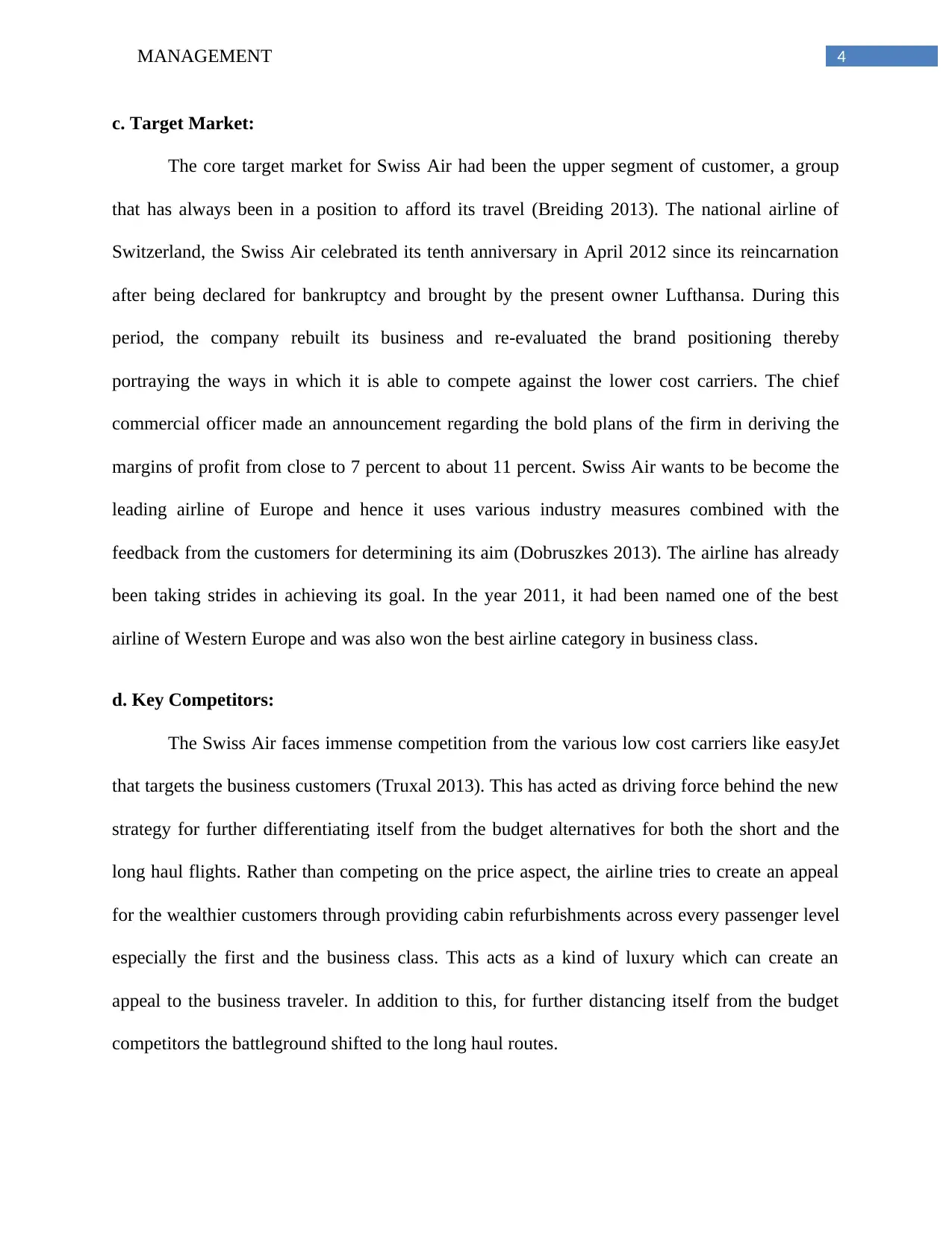
4MANAGEMENT
c. Target Market:
The core target market for Swiss Air had been the upper segment of customer, a group
that has always been in a position to afford its travel (Breiding 2013). The national airline of
Switzerland, the Swiss Air celebrated its tenth anniversary in April 2012 since its reincarnation
after being declared for bankruptcy and brought by the present owner Lufthansa. During this
period, the company rebuilt its business and re-evaluated the brand positioning thereby
portraying the ways in which it is able to compete against the lower cost carriers. The chief
commercial officer made an announcement regarding the bold plans of the firm in deriving the
margins of profit from close to 7 percent to about 11 percent. Swiss Air wants to be become the
leading airline of Europe and hence it uses various industry measures combined with the
feedback from the customers for determining its aim (Dobruszkes 2013). The airline has already
been taking strides in achieving its goal. In the year 2011, it had been named one of the best
airline of Western Europe and was also won the best airline category in business class.
d. Key Competitors:
The Swiss Air faces immense competition from the various low cost carriers like easyJet
that targets the business customers (Truxal 2013). This has acted as driving force behind the new
strategy for further differentiating itself from the budget alternatives for both the short and the
long haul flights. Rather than competing on the price aspect, the airline tries to create an appeal
for the wealthier customers through providing cabin refurbishments across every passenger level
especially the first and the business class. This acts as a kind of luxury which can create an
appeal to the business traveler. In addition to this, for further distancing itself from the budget
competitors the battleground shifted to the long haul routes.
c. Target Market:
The core target market for Swiss Air had been the upper segment of customer, a group
that has always been in a position to afford its travel (Breiding 2013). The national airline of
Switzerland, the Swiss Air celebrated its tenth anniversary in April 2012 since its reincarnation
after being declared for bankruptcy and brought by the present owner Lufthansa. During this
period, the company rebuilt its business and re-evaluated the brand positioning thereby
portraying the ways in which it is able to compete against the lower cost carriers. The chief
commercial officer made an announcement regarding the bold plans of the firm in deriving the
margins of profit from close to 7 percent to about 11 percent. Swiss Air wants to be become the
leading airline of Europe and hence it uses various industry measures combined with the
feedback from the customers for determining its aim (Dobruszkes 2013). The airline has already
been taking strides in achieving its goal. In the year 2011, it had been named one of the best
airline of Western Europe and was also won the best airline category in business class.
d. Key Competitors:
The Swiss Air faces immense competition from the various low cost carriers like easyJet
that targets the business customers (Truxal 2013). This has acted as driving force behind the new
strategy for further differentiating itself from the budget alternatives for both the short and the
long haul flights. Rather than competing on the price aspect, the airline tries to create an appeal
for the wealthier customers through providing cabin refurbishments across every passenger level
especially the first and the business class. This acts as a kind of luxury which can create an
appeal to the business traveler. In addition to this, for further distancing itself from the budget
competitors the battleground shifted to the long haul routes.
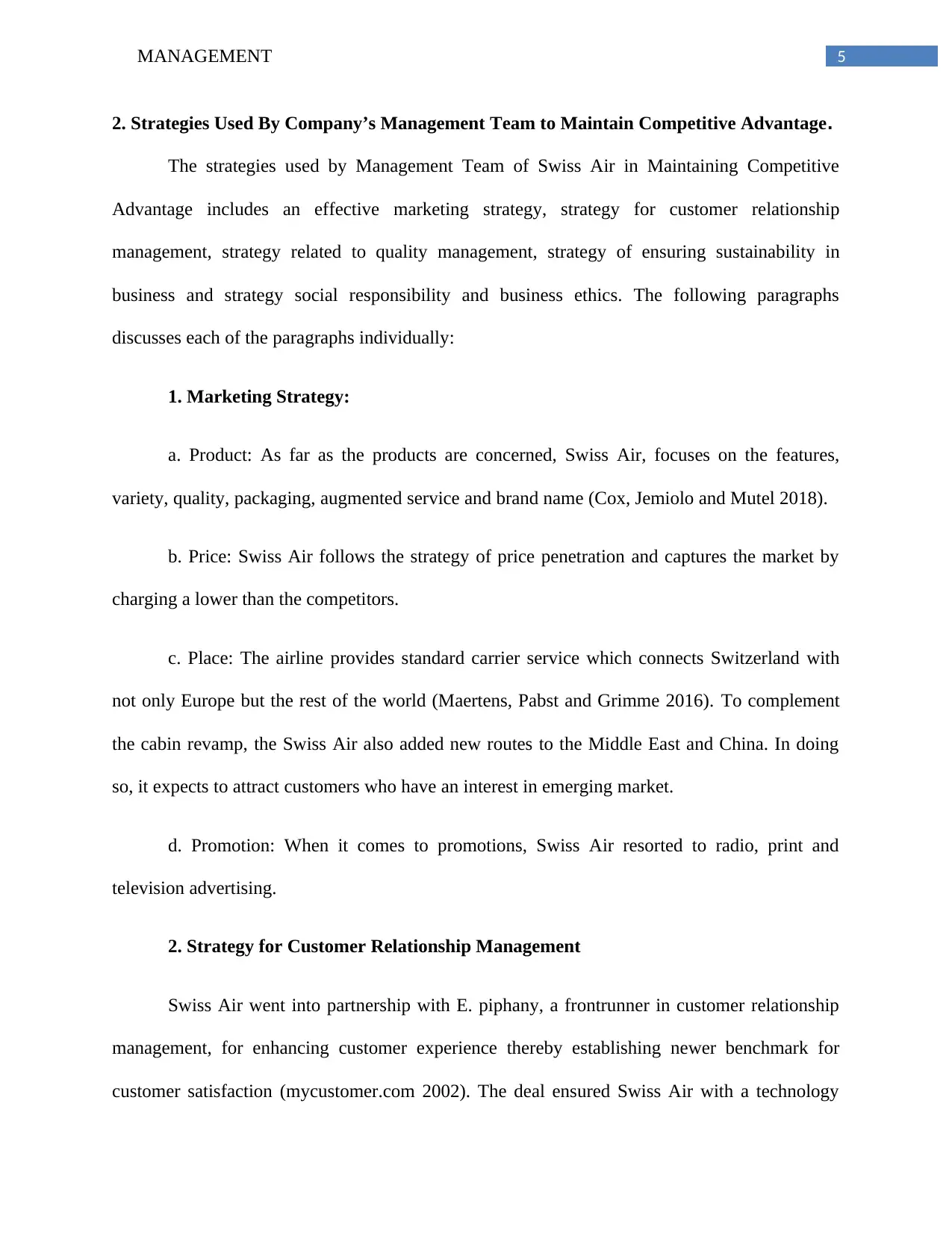
5MANAGEMENT
2. Strategies Used By Company’s Management Team to Maintain Competitive Advantage.
The strategies used by Management Team of Swiss Air in Maintaining Competitive
Advantage includes an effective marketing strategy, strategy for customer relationship
management, strategy related to quality management, strategy of ensuring sustainability in
business and strategy social responsibility and business ethics. The following paragraphs
discusses each of the paragraphs individually:
1. Marketing Strategy:
a. Product: As far as the products are concerned, Swiss Air, focuses on the features,
variety, quality, packaging, augmented service and brand name (Cox, Jemiolo and Mutel 2018).
b. Price: Swiss Air follows the strategy of price penetration and captures the market by
charging a lower than the competitors.
c. Place: The airline provides standard carrier service which connects Switzerland with
not only Europe but the rest of the world (Maertens, Pabst and Grimme 2016). To complement
the cabin revamp, the Swiss Air also added new routes to the Middle East and China. In doing
so, it expects to attract customers who have an interest in emerging market.
d. Promotion: When it comes to promotions, Swiss Air resorted to radio, print and
television advertising.
2. Strategy for Customer Relationship Management
Swiss Air went into partnership with E. piphany, a frontrunner in customer relationship
management, for enhancing customer experience thereby establishing newer benchmark for
customer satisfaction (mycustomer.com 2002). The deal ensured Swiss Air with a technology
2. Strategies Used By Company’s Management Team to Maintain Competitive Advantage.
The strategies used by Management Team of Swiss Air in Maintaining Competitive
Advantage includes an effective marketing strategy, strategy for customer relationship
management, strategy related to quality management, strategy of ensuring sustainability in
business and strategy social responsibility and business ethics. The following paragraphs
discusses each of the paragraphs individually:
1. Marketing Strategy:
a. Product: As far as the products are concerned, Swiss Air, focuses on the features,
variety, quality, packaging, augmented service and brand name (Cox, Jemiolo and Mutel 2018).
b. Price: Swiss Air follows the strategy of price penetration and captures the market by
charging a lower than the competitors.
c. Place: The airline provides standard carrier service which connects Switzerland with
not only Europe but the rest of the world (Maertens, Pabst and Grimme 2016). To complement
the cabin revamp, the Swiss Air also added new routes to the Middle East and China. In doing
so, it expects to attract customers who have an interest in emerging market.
d. Promotion: When it comes to promotions, Swiss Air resorted to radio, print and
television advertising.
2. Strategy for Customer Relationship Management
Swiss Air went into partnership with E. piphany, a frontrunner in customer relationship
management, for enhancing customer experience thereby establishing newer benchmark for
customer satisfaction (mycustomer.com 2002). The deal ensured Swiss Air with a technology
⊘ This is a preview!⊘
Do you want full access?
Subscribe today to unlock all pages.

Trusted by 1+ million students worldwide
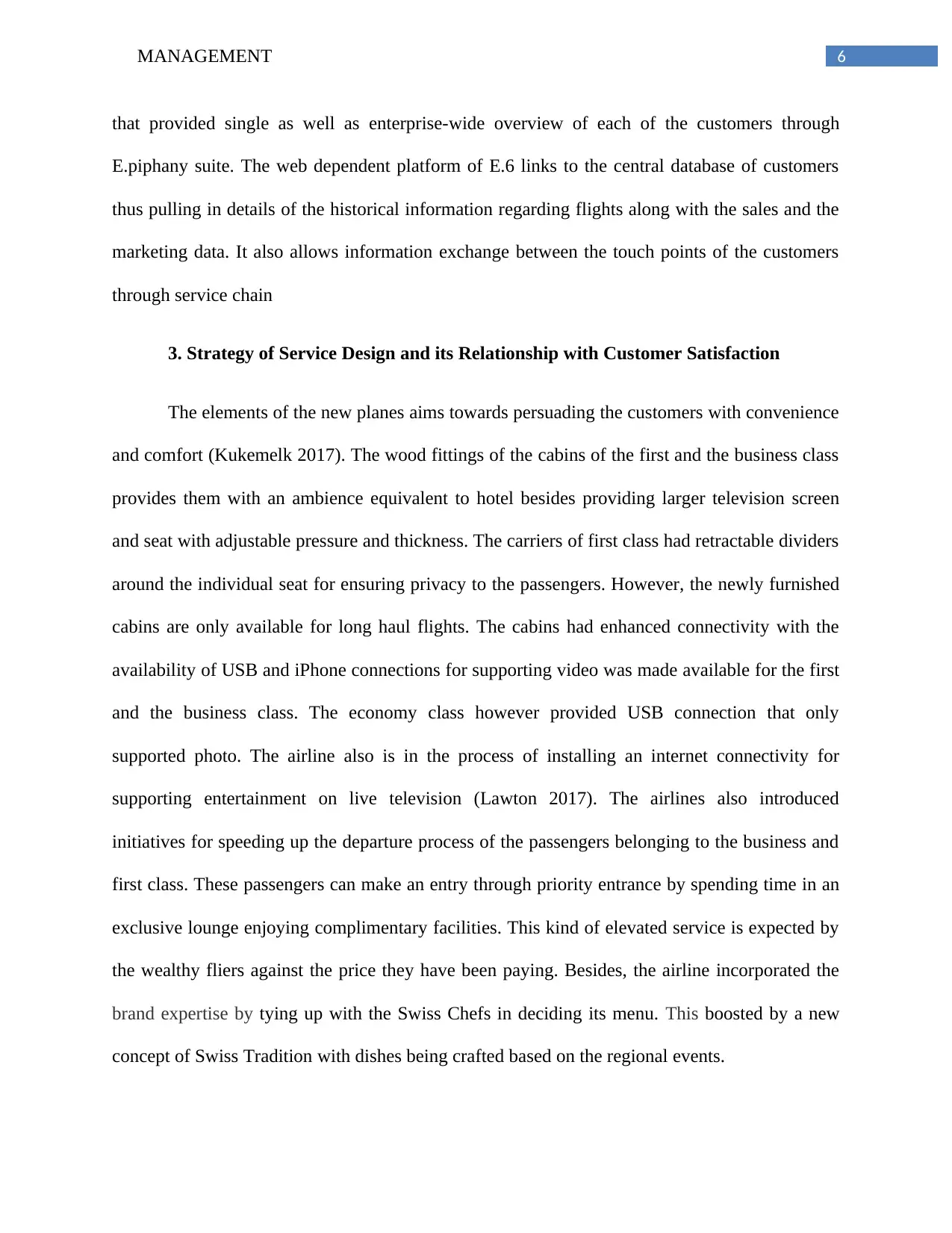
6MANAGEMENT
that provided single as well as enterprise-wide overview of each of the customers through
E.piphany suite. The web dependent platform of E.6 links to the central database of customers
thus pulling in details of the historical information regarding flights along with the sales and the
marketing data. It also allows information exchange between the touch points of the customers
through service chain
3. Strategy of Service Design and its Relationship with Customer Satisfaction
The elements of the new planes aims towards persuading the customers with convenience
and comfort (Kukemelk 2017). The wood fittings of the cabins of the first and the business class
provides them with an ambience equivalent to hotel besides providing larger television screen
and seat with adjustable pressure and thickness. The carriers of first class had retractable dividers
around the individual seat for ensuring privacy to the passengers. However, the newly furnished
cabins are only available for long haul flights. The cabins had enhanced connectivity with the
availability of USB and iPhone connections for supporting video was made available for the first
and the business class. The economy class however provided USB connection that only
supported photo. The airline also is in the process of installing an internet connectivity for
supporting entertainment on live television (Lawton 2017). The airlines also introduced
initiatives for speeding up the departure process of the passengers belonging to the business and
first class. These passengers can make an entry through priority entrance by spending time in an
exclusive lounge enjoying complimentary facilities. This kind of elevated service is expected by
the wealthy fliers against the price they have been paying. Besides, the airline incorporated the
brand expertise by tying up with the Swiss Chefs in deciding its menu. This boosted by a new
concept of Swiss Tradition with dishes being crafted based on the regional events.
that provided single as well as enterprise-wide overview of each of the customers through
E.piphany suite. The web dependent platform of E.6 links to the central database of customers
thus pulling in details of the historical information regarding flights along with the sales and the
marketing data. It also allows information exchange between the touch points of the customers
through service chain
3. Strategy of Service Design and its Relationship with Customer Satisfaction
The elements of the new planes aims towards persuading the customers with convenience
and comfort (Kukemelk 2017). The wood fittings of the cabins of the first and the business class
provides them with an ambience equivalent to hotel besides providing larger television screen
and seat with adjustable pressure and thickness. The carriers of first class had retractable dividers
around the individual seat for ensuring privacy to the passengers. However, the newly furnished
cabins are only available for long haul flights. The cabins had enhanced connectivity with the
availability of USB and iPhone connections for supporting video was made available for the first
and the business class. The economy class however provided USB connection that only
supported photo. The airline also is in the process of installing an internet connectivity for
supporting entertainment on live television (Lawton 2017). The airlines also introduced
initiatives for speeding up the departure process of the passengers belonging to the business and
first class. These passengers can make an entry through priority entrance by spending time in an
exclusive lounge enjoying complimentary facilities. This kind of elevated service is expected by
the wealthy fliers against the price they have been paying. Besides, the airline incorporated the
brand expertise by tying up with the Swiss Chefs in deciding its menu. This boosted by a new
concept of Swiss Tradition with dishes being crafted based on the regional events.
Paraphrase This Document
Need a fresh take? Get an instant paraphrase of this document with our AI Paraphraser
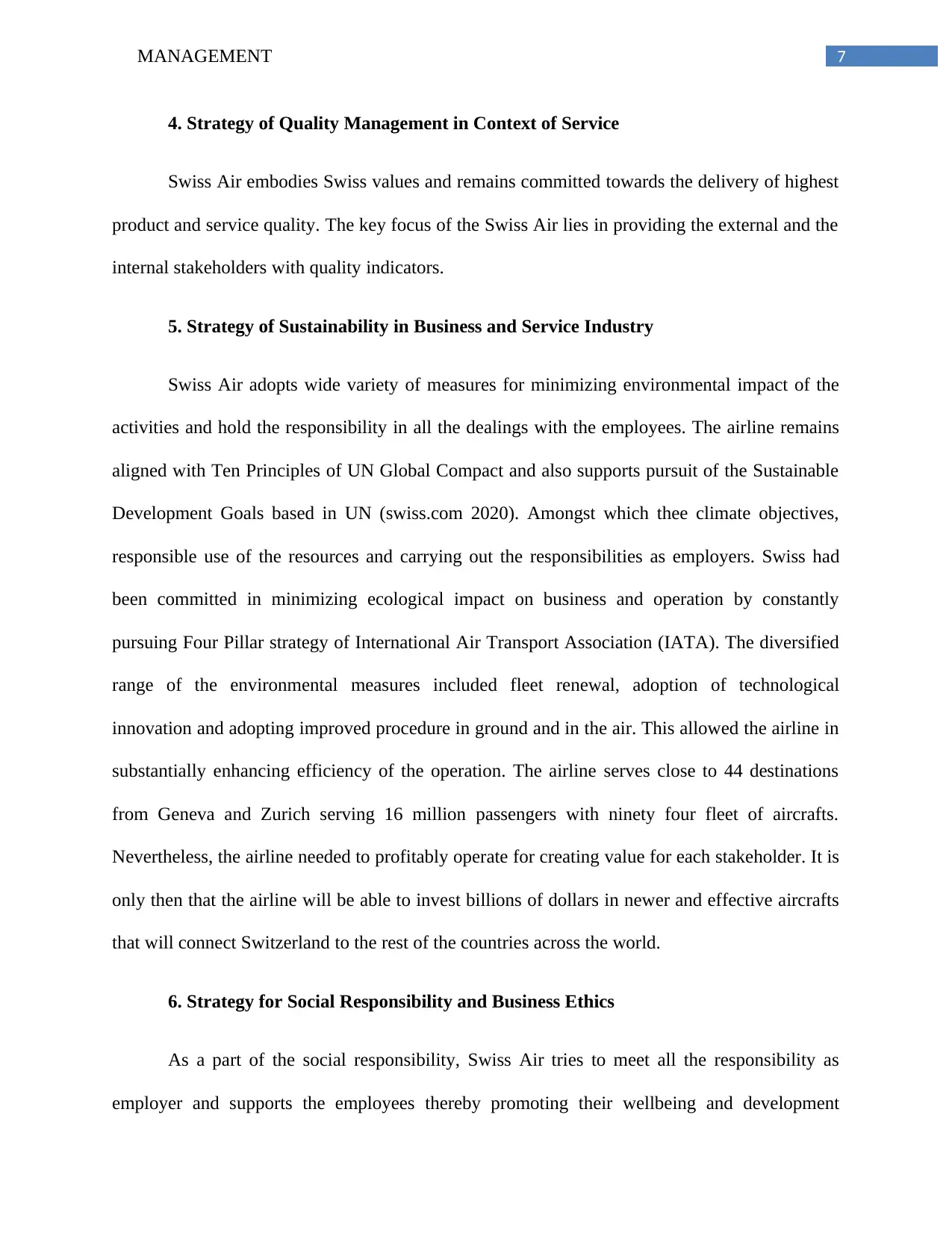
7MANAGEMENT
4. Strategy of Quality Management in Context of Service
Swiss Air embodies Swiss values and remains committed towards the delivery of highest
product and service quality. The key focus of the Swiss Air lies in providing the external and the
internal stakeholders with quality indicators.
5. Strategy of Sustainability in Business and Service Industry
Swiss Air adopts wide variety of measures for minimizing environmental impact of the
activities and hold the responsibility in all the dealings with the employees. The airline remains
aligned with Ten Principles of UN Global Compact and also supports pursuit of the Sustainable
Development Goals based in UN (swiss.com 2020). Amongst which thee climate objectives,
responsible use of the resources and carrying out the responsibilities as employers. Swiss had
been committed in minimizing ecological impact on business and operation by constantly
pursuing Four Pillar strategy of International Air Transport Association (IATA). The diversified
range of the environmental measures included fleet renewal, adoption of technological
innovation and adopting improved procedure in ground and in the air. This allowed the airline in
substantially enhancing efficiency of the operation. The airline serves close to 44 destinations
from Geneva and Zurich serving 16 million passengers with ninety four fleet of aircrafts.
Nevertheless, the airline needed to profitably operate for creating value for each stakeholder. It is
only then that the airline will be able to invest billions of dollars in newer and effective aircrafts
that will connect Switzerland to the rest of the countries across the world.
6. Strategy for Social Responsibility and Business Ethics
As a part of the social responsibility, Swiss Air tries to meet all the responsibility as
employer and supports the employees thereby promoting their wellbeing and development
4. Strategy of Quality Management in Context of Service
Swiss Air embodies Swiss values and remains committed towards the delivery of highest
product and service quality. The key focus of the Swiss Air lies in providing the external and the
internal stakeholders with quality indicators.
5. Strategy of Sustainability in Business and Service Industry
Swiss Air adopts wide variety of measures for minimizing environmental impact of the
activities and hold the responsibility in all the dealings with the employees. The airline remains
aligned with Ten Principles of UN Global Compact and also supports pursuit of the Sustainable
Development Goals based in UN (swiss.com 2020). Amongst which thee climate objectives,
responsible use of the resources and carrying out the responsibilities as employers. Swiss had
been committed in minimizing ecological impact on business and operation by constantly
pursuing Four Pillar strategy of International Air Transport Association (IATA). The diversified
range of the environmental measures included fleet renewal, adoption of technological
innovation and adopting improved procedure in ground and in the air. This allowed the airline in
substantially enhancing efficiency of the operation. The airline serves close to 44 destinations
from Geneva and Zurich serving 16 million passengers with ninety four fleet of aircrafts.
Nevertheless, the airline needed to profitably operate for creating value for each stakeholder. It is
only then that the airline will be able to invest billions of dollars in newer and effective aircrafts
that will connect Switzerland to the rest of the countries across the world.
6. Strategy for Social Responsibility and Business Ethics
As a part of the social responsibility, Swiss Air tries to meet all the responsibility as
employer and supports the employees thereby promoting their wellbeing and development
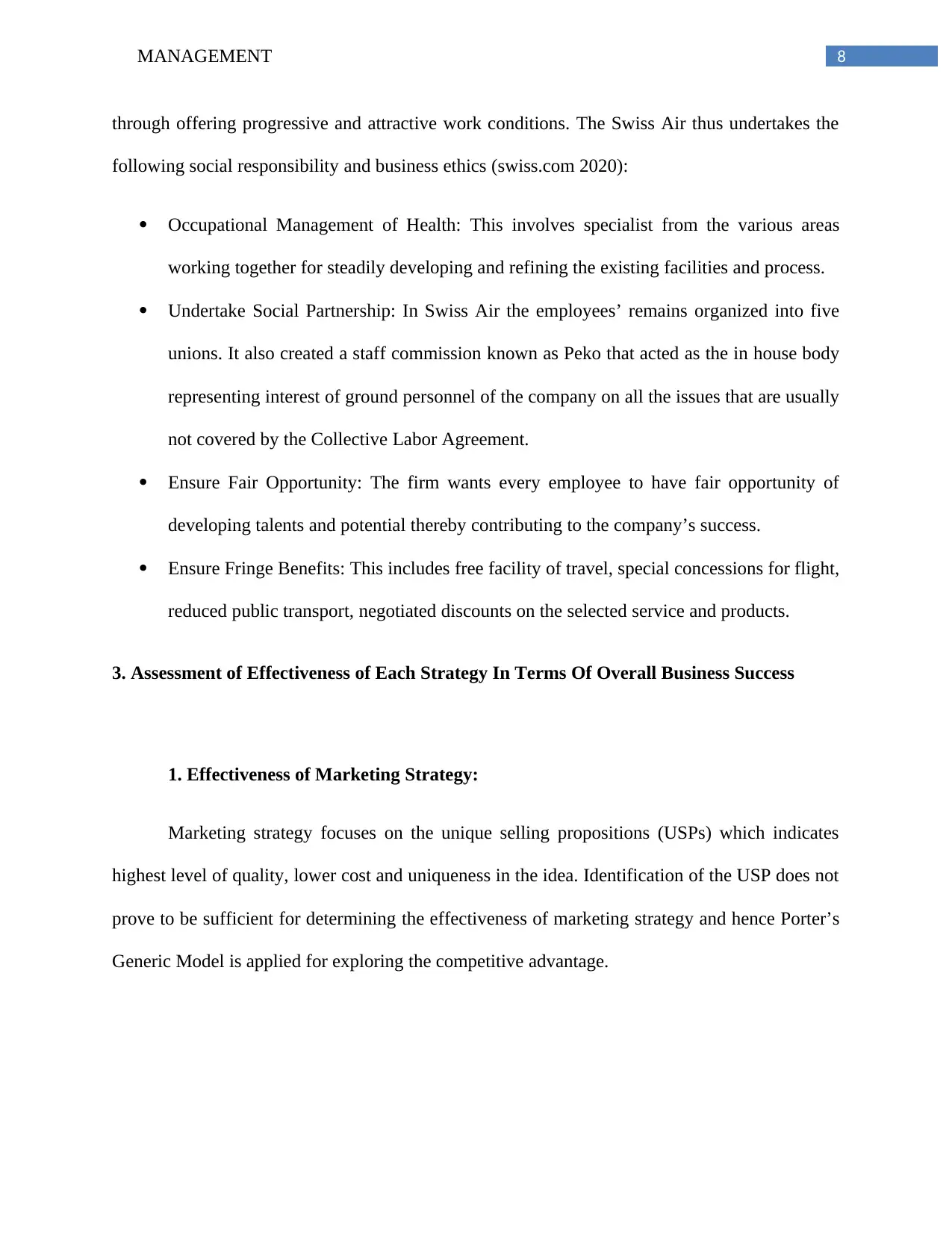
8MANAGEMENT
through offering progressive and attractive work conditions. The Swiss Air thus undertakes the
following social responsibility and business ethics (swiss.com 2020):
Occupational Management of Health: This involves specialist from the various areas
working together for steadily developing and refining the existing facilities and process.
Undertake Social Partnership: In Swiss Air the employees’ remains organized into five
unions. It also created a staff commission known as Peko that acted as the in house body
representing interest of ground personnel of the company on all the issues that are usually
not covered by the Collective Labor Agreement.
Ensure Fair Opportunity: The firm wants every employee to have fair opportunity of
developing talents and potential thereby contributing to the company’s success.
Ensure Fringe Benefits: This includes free facility of travel, special concessions for flight,
reduced public transport, negotiated discounts on the selected service and products.
3. Assessment of Effectiveness of Each Strategy In Terms Of Overall Business Success
1. Effectiveness of Marketing Strategy:
Marketing strategy focuses on the unique selling propositions (USPs) which indicates
highest level of quality, lower cost and uniqueness in the idea. Identification of the USP does not
prove to be sufficient for determining the effectiveness of marketing strategy and hence Porter’s
Generic Model is applied for exploring the competitive advantage.
through offering progressive and attractive work conditions. The Swiss Air thus undertakes the
following social responsibility and business ethics (swiss.com 2020):
Occupational Management of Health: This involves specialist from the various areas
working together for steadily developing and refining the existing facilities and process.
Undertake Social Partnership: In Swiss Air the employees’ remains organized into five
unions. It also created a staff commission known as Peko that acted as the in house body
representing interest of ground personnel of the company on all the issues that are usually
not covered by the Collective Labor Agreement.
Ensure Fair Opportunity: The firm wants every employee to have fair opportunity of
developing talents and potential thereby contributing to the company’s success.
Ensure Fringe Benefits: This includes free facility of travel, special concessions for flight,
reduced public transport, negotiated discounts on the selected service and products.
3. Assessment of Effectiveness of Each Strategy In Terms Of Overall Business Success
1. Effectiveness of Marketing Strategy:
Marketing strategy focuses on the unique selling propositions (USPs) which indicates
highest level of quality, lower cost and uniqueness in the idea. Identification of the USP does not
prove to be sufficient for determining the effectiveness of marketing strategy and hence Porter’s
Generic Model is applied for exploring the competitive advantage.
⊘ This is a preview!⊘
Do you want full access?
Subscribe today to unlock all pages.

Trusted by 1+ million students worldwide
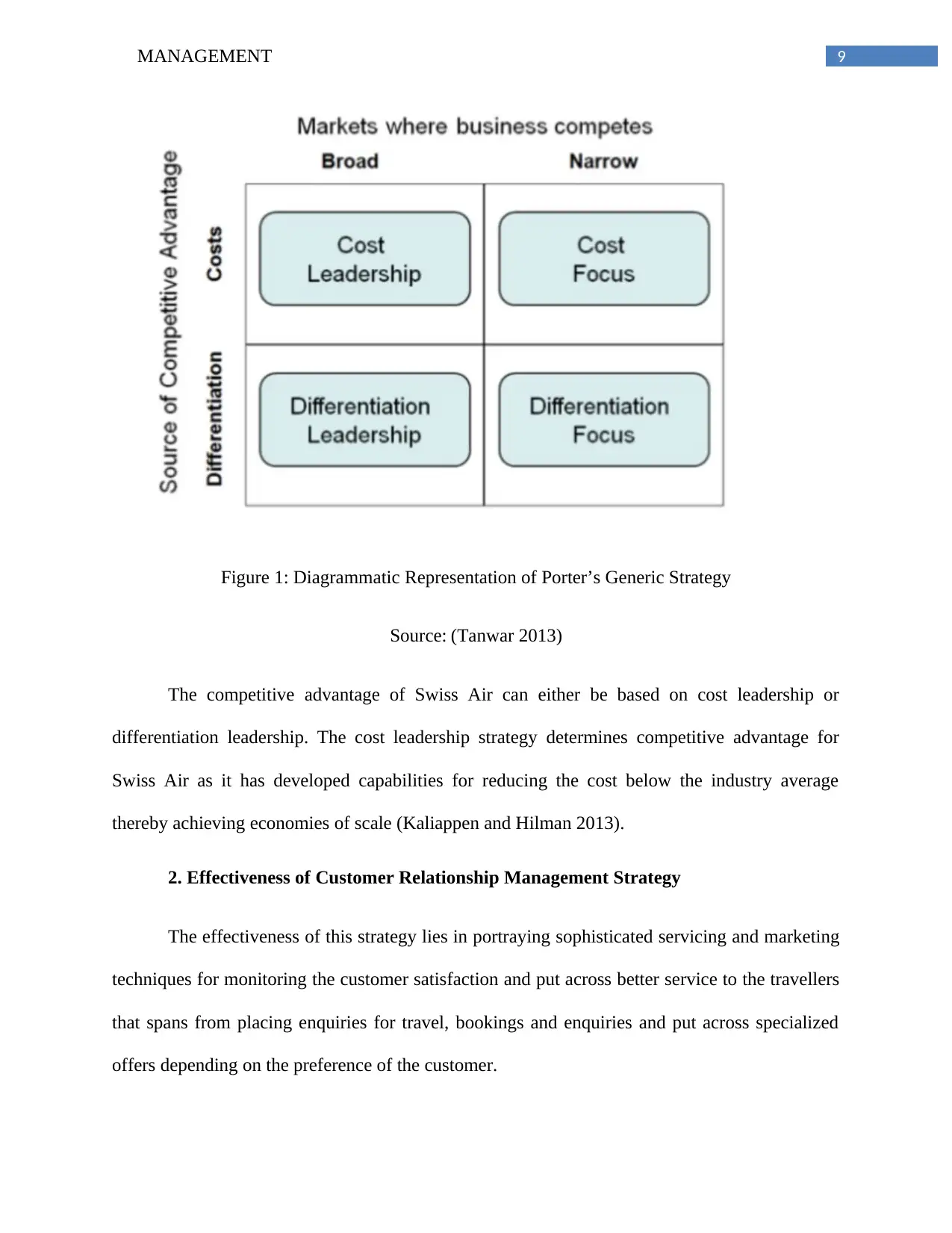
9MANAGEMENT
Figure 1: Diagrammatic Representation of Porter’s Generic Strategy
Source: (Tanwar 2013)
The competitive advantage of Swiss Air can either be based on cost leadership or
differentiation leadership. The cost leadership strategy determines competitive advantage for
Swiss Air as it has developed capabilities for reducing the cost below the industry average
thereby achieving economies of scale (Kaliappen and Hilman 2013).
2. Effectiveness of Customer Relationship Management Strategy
The effectiveness of this strategy lies in portraying sophisticated servicing and marketing
techniques for monitoring the customer satisfaction and put across better service to the travellers
that spans from placing enquiries for travel, bookings and enquiries and put across specialized
offers depending on the preference of the customer.
Figure 1: Diagrammatic Representation of Porter’s Generic Strategy
Source: (Tanwar 2013)
The competitive advantage of Swiss Air can either be based on cost leadership or
differentiation leadership. The cost leadership strategy determines competitive advantage for
Swiss Air as it has developed capabilities for reducing the cost below the industry average
thereby achieving economies of scale (Kaliappen and Hilman 2013).
2. Effectiveness of Customer Relationship Management Strategy
The effectiveness of this strategy lies in portraying sophisticated servicing and marketing
techniques for monitoring the customer satisfaction and put across better service to the travellers
that spans from placing enquiries for travel, bookings and enquiries and put across specialized
offers depending on the preference of the customer.
Paraphrase This Document
Need a fresh take? Get an instant paraphrase of this document with our AI Paraphraser
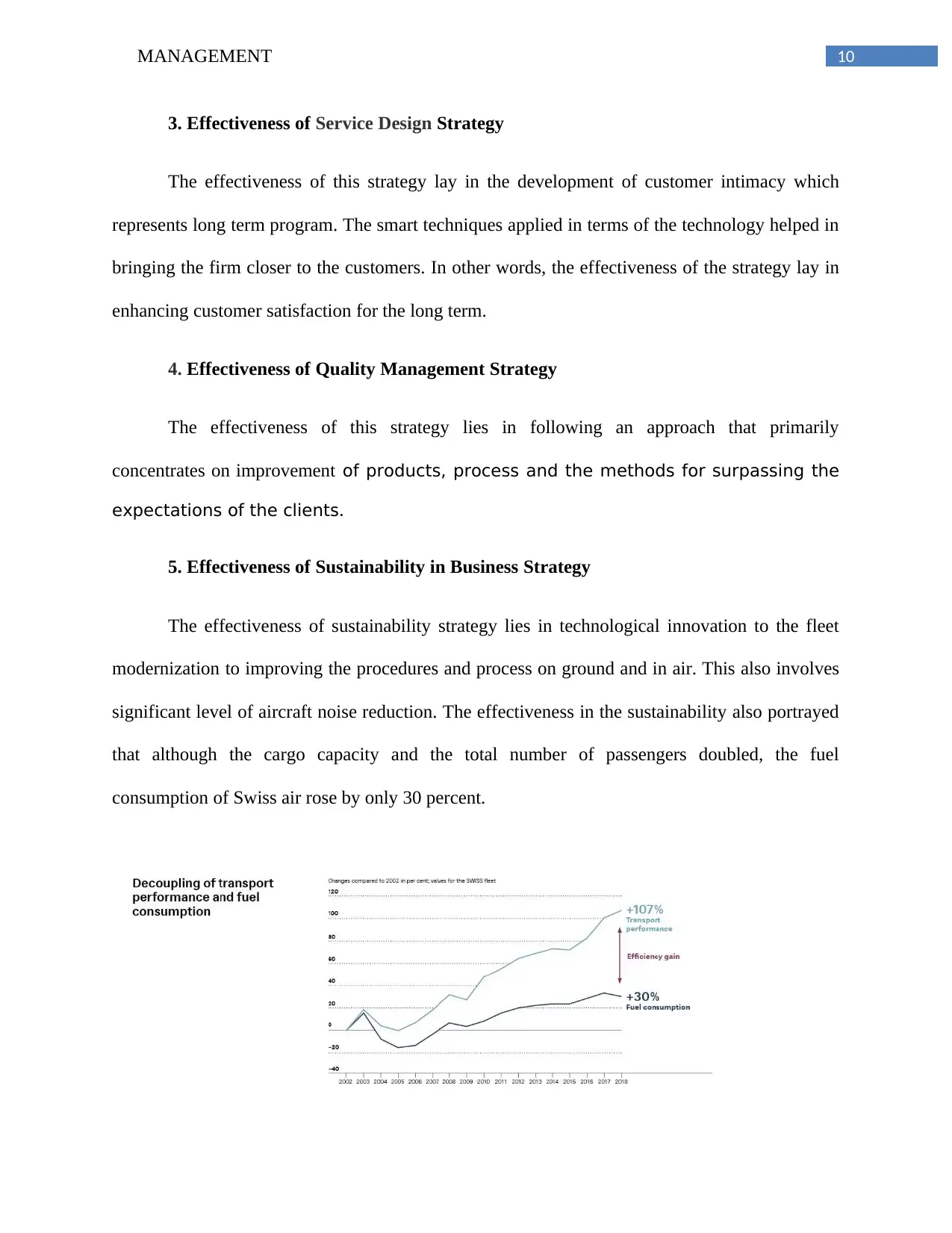
10MANAGEMENT
3. Effectiveness of Service Design Strategy
The effectiveness of this strategy lay in the development of customer intimacy which
represents long term program. The smart techniques applied in terms of the technology helped in
bringing the firm closer to the customers. In other words, the effectiveness of the strategy lay in
enhancing customer satisfaction for the long term.
4. Effectiveness of Quality Management Strategy
The effectiveness of this strategy lies in following an approach that primarily
concentrates on improvement of products, process and the methods for surpassing the
expectations of the clients.
5. Effectiveness of Sustainability in Business Strategy
The effectiveness of sustainability strategy lies in technological innovation to the fleet
modernization to improving the procedures and process on ground and in air. This also involves
significant level of aircraft noise reduction. The effectiveness in the sustainability also portrayed
that although the cargo capacity and the total number of passengers doubled, the fuel
consumption of Swiss air rose by only 30 percent.
3. Effectiveness of Service Design Strategy
The effectiveness of this strategy lay in the development of customer intimacy which
represents long term program. The smart techniques applied in terms of the technology helped in
bringing the firm closer to the customers. In other words, the effectiveness of the strategy lay in
enhancing customer satisfaction for the long term.
4. Effectiveness of Quality Management Strategy
The effectiveness of this strategy lies in following an approach that primarily
concentrates on improvement of products, process and the methods for surpassing the
expectations of the clients.
5. Effectiveness of Sustainability in Business Strategy
The effectiveness of sustainability strategy lies in technological innovation to the fleet
modernization to improving the procedures and process on ground and in air. This also involves
significant level of aircraft noise reduction. The effectiveness in the sustainability also portrayed
that although the cargo capacity and the total number of passengers doubled, the fuel
consumption of Swiss air rose by only 30 percent.
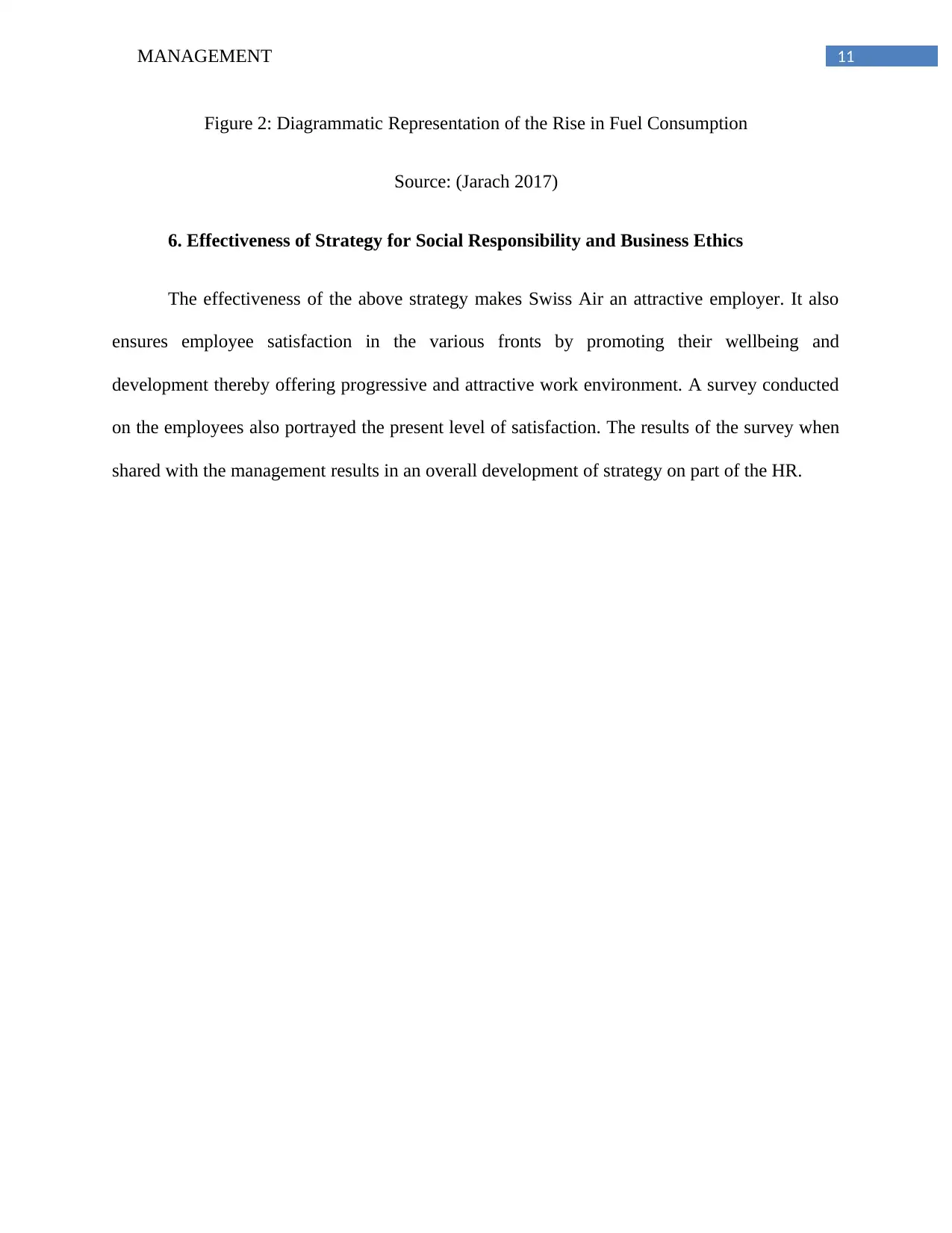
11MANAGEMENT
Figure 2: Diagrammatic Representation of the Rise in Fuel Consumption
Source: (Jarach 2017)
6. Effectiveness of Strategy for Social Responsibility and Business Ethics
The effectiveness of the above strategy makes Swiss Air an attractive employer. It also
ensures employee satisfaction in the various fronts by promoting their wellbeing and
development thereby offering progressive and attractive work environment. A survey conducted
on the employees also portrayed the present level of satisfaction. The results of the survey when
shared with the management results in an overall development of strategy on part of the HR.
Figure 2: Diagrammatic Representation of the Rise in Fuel Consumption
Source: (Jarach 2017)
6. Effectiveness of Strategy for Social Responsibility and Business Ethics
The effectiveness of the above strategy makes Swiss Air an attractive employer. It also
ensures employee satisfaction in the various fronts by promoting their wellbeing and
development thereby offering progressive and attractive work environment. A survey conducted
on the employees also portrayed the present level of satisfaction. The results of the survey when
shared with the management results in an overall development of strategy on part of the HR.
⊘ This is a preview!⊘
Do you want full access?
Subscribe today to unlock all pages.

Trusted by 1+ million students worldwide
1 out of 14
Related Documents
Your All-in-One AI-Powered Toolkit for Academic Success.
+13062052269
info@desklib.com
Available 24*7 on WhatsApp / Email
![[object Object]](/_next/static/media/star-bottom.7253800d.svg)
Unlock your academic potential
Copyright © 2020–2025 A2Z Services. All Rights Reserved. Developed and managed by ZUCOL.



